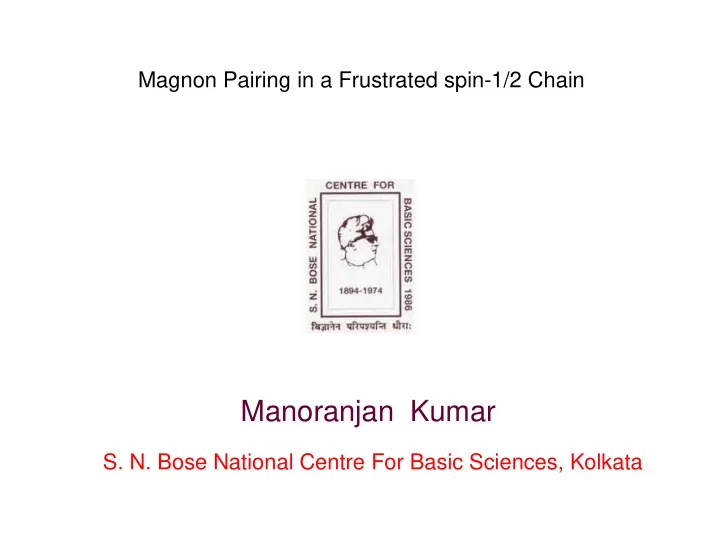

Magnon Pairing in a Frustrated spin-1/2 Chain Manoranjan Kumar S. N. Bose National Centre For Basic Sciences, Kolkata
Plan of talk Spin Model Hamiltonians and its Quantum phase diagram Spin nematic phase Magnon pairs & scaling of their binding energies.
Spin model Hamiltonian J 2 J 1 < 0, 0< J 2 < J c J 1 J 1 <0, J 2 > J c, z ( , ) . . H J J J S S J S S h S 1 2 1 1 2 2 n n n n n n n n J 2 | | Where J 1
Quantum phase diagram VC – Vector chiral Spin Nematic phase In a finite systems, Jump in M-h curve is S z =1 (VC phase) and S z =2 (for NP) Honecker et al (2006), Hikihara et al (2008), Sudan et al (2009) Nishimoto et al (2011)
Modified DMRG • In conventional DMRG only two sites are added at every steps. • In large J 2 in limit, convergence of energies is poor because of uses of twice renormalized operators in construction of Super block. • To avoid the convergence problem, a modified DMRG is used, where four sites are added at a every steps, therefore superblock operators are only once renormalized. Manoranjan et al PRB( 2010 )
Degenerate ground states in presence of magnetic field • For small , even and odd S z, both have degenerate gs. • In this limit, there are energy levels crossing in the systems. • For large >0.6, gs with odd S z is always degenerate, whereas gs with even S z is always non-degenerate. Aslam et. al arXiv:1408.6629v1
Spin Densities In a PBC systems, for >0.6 and in odd S z , (S z -1)/2 are equally distributed to both the degenerate gs. Most part of one extra magnon is confined to one arm of zigzag chain whereas it is equally distributed at both the arms in even S z .
M – h Curve z z (S 1) (S 0) S z =1, jumps in open boundary condition E E 1 z z (S 2) (S 0) E E 2 1 and 2 both extrapolates to zero. Therefore, jump of Sz =1 , VC phase is absent for > 0.6 Aslam et. al arXiv:1408.6629v1
New Quantum phase Diagram • Energy levels crossing and jump in magnetization is used to construct the phase diagram. • VC phase vanishes for >0.6. Aslam et. al arXiv:1408.6629v1
Spin Nematic phase It exist at >0.4 and finite magnetic field in spin chains. •The single boson propagator f(r) decays slower compare to density fluctuations g(r) in the commensurate nematic phase . (r) f S S S S 0 1 1 r r z z z z g(r) S S S S Hikihara , PRB (2008) 0 r 0 r Therefore it is appropriate to call the spin nematic phase. This phase is a TL of hard core bosons which are two magnon bound states. Jump of S z =2 in the M-h plot is signature of bound magnon pair states.
Spin Nematic phase In the incommensurate nematic phase, density-density correlation function is more dominant than the single boson propagator. Field theoretical results of hard core bosons of bound magnons predicts the spin correlation 2 p A z z 2 cos(2 ) S S M r 0 r 2 2 4 | | r r 1 1 ( ) M 2 p Pitch angle can be given in the incommensurate nematic phase as 1 (1 M Hikihara , PRB (2008) ) p M s
Pitch angle R From DMRG calculations, one can calculate pitch angle by using 2 R
Pitch angle Pitch angle slope depends on the p. For nematic region (two magnon bound region), p=2 For three magnon bound region, p=3
Binding energy of magnons pairs in nematic phase The M-h curve in the nametic phase, magnetic jumps are S z =2. In this phase, two magons are paired to form a hard core boson like object. Binding energy of magnon pairs can given by z z z z ( (S 2) (S )) (E(S 1) E(S )) 2 E E N E N N N b Where N is number of magnons. E b is difference in energy for creating two magnons and twice of energy for creating one magnon. M. E. Zhitomirsky et. EPL (2010) Hikihara , PRB (2008)
Finite size effect on E b E b shows very weak dependence on the system size.
Dependence of E b on E b decreases with |J 2 /J 1 | , larger the M, bigger is E b.
Dependence of E b on E b decreases exponentially with J 1 /J 2 . e ( )|J / | M J / E J 1 2 2 b For small M, E b is quite small number.
Dependence of E b on M (M) M 2 Binding energies decay much faster for large M.
Summary •In the nematic phase, exact diagonalization results show doubly degenerate ground state in the odd sector of s z . •Vector Chiral phase exists only in very small parameter regime. • Binding energies of the magnon pairs decrease exponentially with J 1 /J 2 .
Thank You
Recommend
More recommend